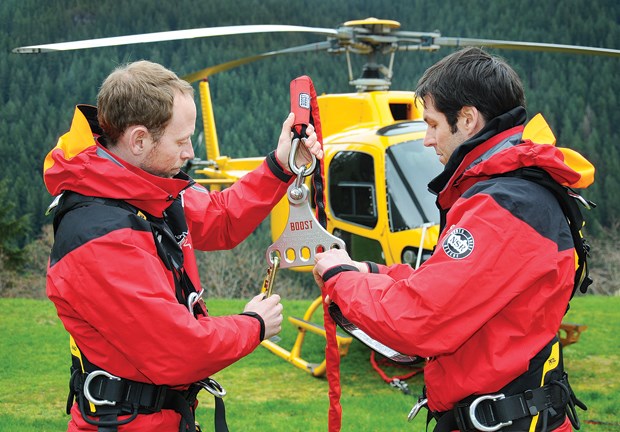A small drone takes off from a ridge high in the North Shore mountains and swoops down the vertical track of a river gully, hovering over boulders and waterfalls under low cloud cover.
Images from the camera mounted on the drone are beamed back to a computer, where North Shore Rescue’s search team leaders scan the video for clues in the white-grey background or check for infrared heat signatures among remote swaths of ice and snow. For those who are lost or injured in the backcountry, such technology could one day soon make the difference between life and death.
Last week, provincial Emergency Management B.C. informed search and rescue teams across the province they can now request the use of RCMP drones to help in searches.
The RCMP currently has a small fleet of drones in use across the province to assess traffic accidents, help find missing persons and assist with emergency response planning in serious incidents.
Three Lower Mainland drones – and the specialist “pilots” who fly them from the ground – are based in Surrey. Search and rescue teams will now be able to request their help when needed in the field.
But North Shore Rescue is already one step ahead.
The team is in the process of putting together a specially trained drone team of its own members. Team leaders hope those people will eventually be able to fly the team’s own drones to help in local rescues.
Among the five local search team members being trained as drone pilots are a trained commercial pilot, trained aircraft engineer, an electrical engineer and those experienced in remote-controlled model airplanes.
“We’re kind of riding this wave of development that’s happening right now,” said Curtis Jones, a spokesman for North Shore Rescue, about the drone program. “We want to be at the pointy end of the stick on this. We don’t want to be keeping up.”
North Shore Rescue and other search teams are currently working with Emergency Management B.C. to pilot the technology and come up with guidelines to allow use of drones in search and rescue.
The team’s first drone is a small, light model, ideal for training purposes – particularly since larger drones are subject to more stringent regulation by Transport Canada.
Jones said if the first phase of their pilot program goes well, the team would eventually like to expand to larger sized drones that could carry equipment with better capabilities – like an infrared camera.
That’s something that might have helped with a search like the one for missing British tourist Tom Billings – who disappeared in the Haynes Valley two years ago. “It allows us to scan a vast area with very little taxpayer dollars being expended, compared to the same work in a helicopter,” said Jones, although he added he doesn't see drones replacing helicopters in most circumstances.
There are still some challenges with drones – they must remain in the ground operator’s line of sight, for instance, aren’t allowed to fly over 90 metres above ground level and most can’t fly in really bad weather – including snow and high wind. They also can’t be flown at night or over built-up areas.
Jones said North Shore Rescue is treading carefully, and is working with legal experts to address issues like privacy concerns.
But for longer-term searches – to do reconnaissance over vast search areas and in situations where a helicopter can’t fly or ground teams can’t venture in because of avalanche risk – drones could prove invaluable in the future.
Currently, search teams are still considered “commercial operators” by Transport Canada, and subject to a host of regulations.
Search teams are hoping the pilot programs will help regulators agree to eventually streamline some of those when it comes to using drones in emergencies.
The budget for the first phase of North Shore Rescue’s drone program is $5,000 including equipment and training.
The team is also currently talking to a supplier about the possibility of acquiring a larger, waterproof model, said Jones. He’s hoping drones will be deployed on searches soon, starting this summer.
“We’re hoping this is something that doesn’t frighten off the regulators and they embrace this technology for what it is – something that could really enhance our operation.”



